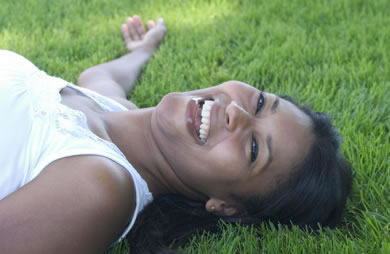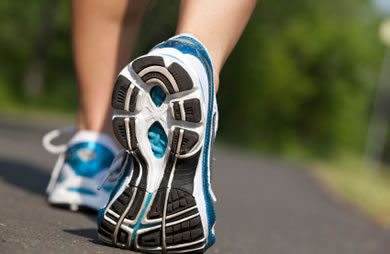It was my five-days-without-a-shower (TMI?) trip to the bottom of the Grand Canyon that taught me about the amazing properties of wool.
Most of us think of wool as the fabric for our winter sweaters or hats, but as I shopped at outdoor and camping stores for my trip, wool was everywhere. Wool underwear, wool hiking socks, wool base layers, wool running tights, wool everything. "What's with all this wool?" I wondered?
Since then, I've learned (and experienced) what an extremely versatile material wool really is. Beyond winter fashion, wool is one of the best materials for exercise clothing—and not just in the winter. I now have a wool neck gaiter, wool base layers for running, and socks, which are not only the socks I wear every day but also the only socks I'll wear while running.
Still not convinced? Allow me to share the six amazing reasons you should be adding more wool to your workout wardrobe (plus tips for choosing the right wool).
- Wool doesn't stink. I'm not a wool or fabric scientist, so I can't explain why this is the case, but it's the truth. When I wore the same pair of socks for 5 days of hiking, my feet didn't stink at all—and neither did my shoes or socks. Although performance workout clothes do tend to get a little stinky after they've been sweated in several times, the wool clothes that I work out in have never taken on that stinky workout smell. For me, that's more bang for my buck because I can wear wool clothes longer (and more times between washes) without them smelling rancid. And for people who do hike or camp, you can get away with packing less and wearing more of the same clothes without offending your nose.
- Wool lasts a long time. I wouldn't say that wool costs any more than my other workout apparel addiction (ahem, Lululemon!), but when I buy wool clothes I know I'm making a sound investment. Because they don't stink over time and because they're strong materials, they don't get holes in them or wear down or wear out as quickly as my other workout clothes do. "We have clients who have had their apparel since we stared in the early 1990s," says Lee Weinstein, a representive from the wool-apparel company Icebreaker. I've punished my wool workout clothes in regular workouts for many years and they still look, smell and perform as well as they did on day one.
- Wool warms…and cools. What's so interesting to me about wool is that it almost adapts to your needs. Wool is a very insulating material, which makes it great for winter workout layering. At the same time, like high-tech performance wear, wool is also breathable. It keeps you cool and allows for air circulation. It's a pretty amazing duality. I can wear the same wool top when it's 40 degrees out and be and be equally warm against the weather, but cool despite the fact that I'm working so hard. At the same time, I can wear that top as a base layer when it's 20 degrees out and still feel cool yet warm. You can find thin wool tops designed for summer workouts and hot weather, as well as products that are thicker and made for much colder temperatures. Merino is "great in the heat and humidity," says Weinstein. Lighter wools "offer the same no-stink, no-itch moisture wicking properties as heavier weight merino apparel," he adds.
- Wool wicks moisture. Like your favorite performance workout clothes, wool wicks away moisture keeping you dry while you exercise. Here's a case in point. I can go running in a total downpour, sloshing through puddles for miles. But when I wear my wool socks my feet feel and stay dry and I never get a blister. I wear wool socks for every run, especially long runs or half-marathon race day and I've never once had a blister. Weinstein adds that, "Wool socks can also be worn for days without a wash because they, too, don't hold odor, and you can even wear merino underwear and running bras." (I might have to try those myself!)
- Wool is easy to care for. I don't have to do anything special when laundering my wool workout clothes. I pop them in the washer with regular detergent and everything else in the load. I do hang dry them (but you don't usually have to), and I don't have to be delicate with them or do multiple washes on a separate or gentle cycle. Wool is simply easy! You should refer to the care instructions on your garment; some merino apparel should be laid flat to dry.
- Wool is natural. Some would even say it's eco-friendly (a renewable resource that's also biodegradable!). I seek out natural ingredients for my food, natural cleaners for my home, and natural materials for my clothes. I almost never buy clothing that is synthetic or acrylic, but I always make an exception for workout clothes. Synthetic materials give performance wear its moisture-wicking power, and I'm not about to tromp about in a sweat-soaked cotton T-shirt. While synthetics are made from petroleum-based plastic (weird, eh?) and in far-away countries, wool naturally has those same properties (and then some) and is often constructed from fair-trade yarns that are sustainably harvested (for lack of a better term) and/or sewn right here in the USA. I'm not going to trade in all my cute performance tops for wool, but I have purposely been adding more wool to my exercise wardrobe over the last couple of years—and I can feel good about those purchases.
Intrigued? Do it right, as not all wool is created equally. That wool sweater you bought at the Gap or received from Grandma isn't the same as performance wool. Work out in that and you'll find yourself overly sweaty and super itchy/uncomfortable. Regular wool is much too thick and scratchy for working out. What's the difference? Weinstein explains:
"First off, there's traditional wool, like granny wore, and then there's merino wool. Merino insulates naturally because it comes from the sheep. Icebreaker's merino wool is grown in the Southern Alps of New Zealand, where it must work for sheep in extremely hot days, yet be insulating and warm when temperatures at the 12,000 foot level drop below freezing. Merino wool comes from a much smaller fiber, as a result it doesn't itch, and feels wonderfully soft a supple against your skin. It's fantastic for exercise -- it naturally wicks moisture, plus it doesn't hold odor like synthetics or cotton. You can literally wear your Icebreaker merino workout apparel for days or weeks without a wash, saving you on detergent and more."
The two biggest names in wool workout apparel are SmartWool and Icebreaker (pictured above), both of which use soft merino wool in their products. (I'm sure there are many more brands that I'm not mentioning, so please share your favorites in the comments!). You can find some wool workout clothes at big-box sporting goods stores, but specialty workout/running stores along with camping/outdoor stores (especially REI) generally have the best selection.
You'll definitely spend more money for wool apparel than you will on non-performance clothing (think cotton T-shirts or socks) and performance clothing alike, in my experience. Wool socks will set you back $12-$20 per pair on average, which may seem steep but when I think about how many pairs of cotton socks I would have bought and replaced the last three years, I realize I'm probably spending less on the wool ones, which I can wear multiple days in a row. The long-sleeve wool running shirts I recently purchased were about $85 each, a little more than I'd spend on a brand new performance shirt for winter layering. But I don't need additional shirts because I can re-wear the same one several times in the week. Plus my experience tells me that the wool product will last years longer and be more versatile overall (I also wear merino not working out!), so I consider it worth the higher cost. If anything, it's a nice splurge every so often when I want to treat myself.
Curious about trying wool but don't want to pay the high price tag? Late winter and early fall are both great times to buy the merchandise that retailers want to clear out. I just say a summer tank top on sale at my local running store for 75% off, which made it less than $20, and now is the time to look for sales on the thicker wool layering pieces designed for winter.
Photo Credit: IceBreaker.com (Everything on the model is wool workout clothing by Ice Breaker.)
Have I convinced you? Would you (or do you) work out in wool?
|
|















